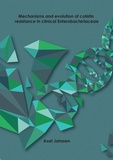Mechanisms and evolution of colistin resistance in clinical Enterobacteriaceae
Summary
Colistin is increasingly used as a last resort drug to treat infections with multidrug resistant Gram-negative bacteria. Colistin acts specifically on Gram negative bacteria due to the selective presence of lipopolysaccharides in the membranes of Gram-negatives. Through electrostatic interaction with lipopolysaccharides, colistin is able to destabilize the membranes of Gram-negatives. However, due to its previous fall into disuse, there is a gap in the knowledge about the evolution and mechanisms of colistin resistance. In this thesis, we have examined the evolution and mechanisms of colistin resistance in Enterobacteriaceae.
We examined the mechanisms of colistin resistance in E. coli strains isolated from bloodstream infections, and diverse Enterobacteriaceae isolated from patients admitted to an intensive care unit, receiving the colistin-containing selective decontamination of the digestive tract treatment. We observed a low prevalence of resistance to this last-resort drug in the Netherlands. In addition, we did not detect clonal relationships between the colistin resistant strains isolated from patients, indicating independent acquisition of colistin resistance in all isolates. Through the construction of mutant E. coli and K. pneumoniae strains, we have determined the contribution of mutations in the PhoPQ, and PmrAB two component regulatory systems to cause colistin resistance. By performing an in vitro evolution experiment by growing colistin-susceptible K. pneumoniae strains under increasing concentrations of colistin, we have determined that the evolution of colistin resistance is these strains occurred through the swift and selective fixation of beneficial mutations in systems associated with LPS modification. The evolution of colistin resistance in K. pneumoniae had a variable effect on virulence characteristics in these strains, including the decreased susceptibility to the human antimicrobial peptide LL-37, increased susceptibility to the humoral complement system, and increased virulence in an C. elegans survival model.
Through mass spectrometry analyses of E. coli strains, we observed the modification of lipid A with phosphoethanolamine. In K. pneumoniae, lipid A may be modified through hydroxyl-groups, palmitate-groups, and of 4-amino-4-deoxy-L-arabinose.
This thesis shows the diverse evolutionary pathways Enterobacteriaceae may use to become resistant to colistin. We observe that mutations leading to colistin resistance may be selected swiftly, and without a necessary impact on fitness.
